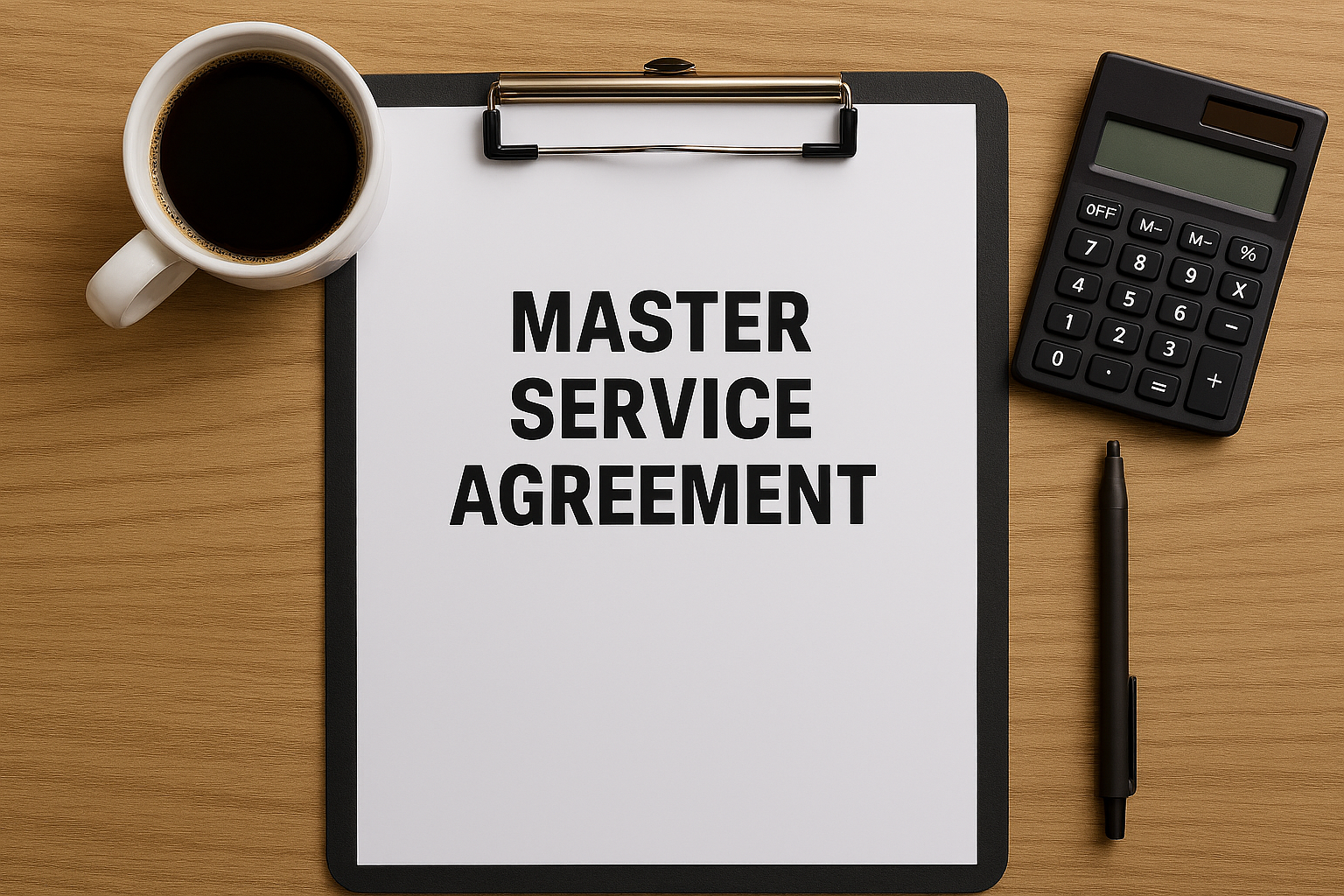
If you work with vendors, consultants, or other service providers on an ongoing basis — or if you’re on the other side of the business relationship as the seller — you don’t want to renegotiate the same terms every time you start a new project. That’s where a master service agreement (MSA) comes in.
An MSA sets the ground rules for the business relationship so individual projects can move forward faster, with fewer legal headaches. Think of it as the “relationship contract” that supports all the individual project contracts to come.
Handled well, an MSA can save weeks of negotiation, reduce misunderstandings, and provide legal protection if things go wrong. Handled poorly…it can lock you into unfavorable terms for years.
What Is an MSA?
An MSA is a contract between two parties that defines the general terms and conditions for their ongoing business relationship. Instead of drafting a brand-new agreement from scratch for every project, the MSA provides a standard framework, and the project-specific details get filled in through separate statements of work (SOWs) or work orders.
An MSA typically covers:
- Scope of relationship — The types of services the provider will perform
- Payment terms — How and when invoices will be issued and paid
- Intellectual property (IP) rights — Who owns the work product created during the engagement
- Confidentiality — How the parties will handle sensitive information
- Warranties and representations — The assurances each party is making
- Liability limitations — Caps or exclusions on damages if something goes wrong
- Termination clauses — How either party can end the agreement
- Dispute resolution — How the parties will handle disagreements (e.g., mediation, arbitration, litigation)
- Governing law — Which jurisdiction’s laws will apply
Once an MSA is signed, both sides can quickly execute new projects by referencing the MSA in the project-specific SOW, saving time and reducing legal review cycles.
How Is an MSA Different From Other Contracts?
An MSA isn’t the only type of agreement you’ll encounter in business, but it plays a unique role. Here’s how it relates to certain other types of contracts:
MSA vs. SOW
The MSA sets the overall framework for the relationship: payment terms, IP rights, liability limits, dispute resolution, and more. The SOW outlines the specific work for a particular project: scope, deliverables, deadlines, and pricing for that engagement. Together, they form the complete contract for that project.
MSA vs. NDA
An NDA (non-disclosure agreement) deals only with confidentiality — what information each party must protect and how they can use it. An MSA may include a confidentiality clause, but it also addresses the full range of commercial and legal terms that govern the relationship. Parties often sign an NDA as a precaution before starting discussions or negotiations for a full commercial agreement.
MSA vs. Project-Specific Contract
Without an MSA, you might end up drafting a brand-new contract for every individual engagement. That means renegotiating payment terms, liability caps, and IP rights each time, slowing things down by introducing unnecessary friction into the business arrangement. With an MSA in place, you can launch new projects faster by simply adding an SOW under the existing terms.
When and Why Are MSAs Used?
You use an MSA when you expect to work with the same vendor or client repeatedly over time. Instead of drafting and negotiating a new contract for each engagement, the MSA creates a standing set of terms you can apply to any project you do together.
Common scenarios include:
- Long-term vendor or client relationships — For example, a marketing agency providing campaigns year-round for the same brand
- Consulting engagements — Especially when the work may span multiple projects or phases over months or years
- Software development or IT services — Where ongoing updates, support, and new feature builds are part of the relationship
- Manufacturing and supply agreements — Particularly for custom or recurring production runs
- Government or enterprise procurement — Where standard terms are required before awarding specific work orders
The main benefit of this style of arrangement is efficiency. With an MSA in place, you avoid renegotiating the same terms every time more work needs to be done. You only need to define the project-specific details in an SOW or work order, which keeps deals moving and reduces legal review time.
Who Drafts and Reviews an MSA?
An MSA isn’t just a legal document drafted in isolation; it’s the product of collaboration across teams.
Drafting
The party providing the first draft — typically the vendor — has its legal and business teams collaborate to prepare terms that protect its interests and reflect how the team will deliver the services. If the buyer controls the drafting (more common with large companies or government entities), their procurement and legal teams typically collaborate to set the framework.
Review
Both companies’ legal teams review and negotiate the terms, exchanging redlines until they reach an agreement — or decide to walk away from the deal. This back-and-forth can be the most time-consuming stage, especially for complex or high-value relationships.
Approval
Authorized signers on both sides sign off once the final language reflects each party’s business goals and risk tolerance.
When done well, this process aligns legal protections with operational realities. The result is an agreement that’s not only enforceable, but practical for the people who use it.
Common Mistakes (and How to Avoid Them)
Even seasoned legal and business teams make avoidable mistakes with MSAs. A few of the most common:
Unresolved Inconsistencies
If the MSA says one thing but the SOW says another, you’ve set the stage for confusion and disputes.
How to avoid it: Always cross-check before signing to make sure the SOW doesn’t contradict the MSA. Flag and reconcile any conflicts.
Vague or One-Sided Clauses
Broad, undefined terms might seem flexible, but they leave too much room for interpretation — which can unfairly benefit one side in a dispute. Similarly, clauses that lean too far in one party’s favor invite pushback and tend to hamper negotiation.
How to avoid it: Define key terms precisely, and aim for balanced language that protects both sides while still advancing your interests.
Missed Updates
An MSA isn’t something you “set and forget.” If laws or external regulations change, or the vendor’s service model evolves, outdated terms can create compliance risks or operational headaches.
How to avoid it: Review the MSA at least annually, and schedule mid-term amendments if legal or business conditions shift.
Insufficient Dispute Resolution Mechanisms
Without clear rules for resolving disputes, even minor disagreements can escalate into expensive litigation.
How to avoid it: Decide up front how you’ll handle conflicts (typically mediation, arbitration, or court), set jurisdiction and venue, and agree on a timeline for resolution before the project starts.
Risks of Skipping or Misusing an MSA
An MSA isn’t just paperwork; it’s the framework that protects both sides of a long-term relationship. Skip it or prepare it poorly, and you invite headaches that can ripple through every project.
Misaligned Expectations
Without a shared baseline, teams may interpret obligations differently. What one side thinks is “included” may be extra work to the other — and both believe they’re right.
Scope Creep
When there’s no agreed framework, additional work often slips in piece by piece. Over time, that erodes profitability for the vendor and strains the relationship.
Delays From Constant Renegotiation
Without an MSA in place, you’re forced to rehash the same general terms for every new project. Those extra hours (which can easily add up to weeks) of legal back-and-forth slow down delivery and may lead to missed business opportunities.
Increased Legal Exposure
An incomplete or missing MSA can leave gaps in indemnities, liability caps, IP ownership, and other critical protections. Those gaps may end up costing far more than the time and legal fees saved by skipping the agreement.
Damaged Relationships and Reputational Harm
Poorly defined terms can turn small misunderstandings into serious disputes. Even if you resolve them, the friction can tarnish trust and make future work less likely.
How to Review MSAs Efficiently
MSAs are meant to save time and prevent conflict, but that won’t happen unless you have an efficient way to create and review them. Here are a few ways to streamline the process without sacrificing quality:
Start From a Vetted Template
If you’re the drafting party, begin with language that’s already been reviewed and approved by your legal team. That way, you’re customizing from a solid foundation instead of reinventing the wheel.
Use Clause Libraries to Check for Gaps
A well-organized clause library makes it easy to spot missing protections — such as indemnity, liability limits, or IP rights — before they become a problem.
Collaborate in Real Time
Shared redlining and version control tools prevent the chaos of multiple email threads and conflicting document versions. Everyone works from the same page, literally.
Watch for Cross-References
Don’t stop at the MSA. Check for consistency with SOWs, NDAs, and other related agreements. Cross-references that don’t line up can undermine the whole framework.
Draft MSAs Better With BoostDraft
BoostDraft speeds MSA review by surfacing key terms and definitions, and making cross-document consistency checks painless. Get a demo to see how you can review MSAs faster and with more confidence.

